Few products have had as big an impact on road cycling safety in recent years as the Garmin Varia. It unfortunately can’t actually reach into an approaching vehicle and rip that smartphone out of the driver’s hand (as much as I wish it could). However, its rear-facing radar unit at least gives you virtual eyes in the back of your head so you have some advance warning that something is coming up, and the way it adjusts its blinking pattern is the next best thing to you jumping up and waving your arms in the air like a maniac in an effort to be seen.
Garmin surely has been enjoying some solid sales on the Varia, too. Multiple iterations have been released over the last few years, and the latest one even has a built-in camera that’s designed to pull people away from Cycliq’s Fly6.
Yet as revelatory as the Varia ecosystem of radar units has been, there’s been one persistent letdown: the mount. Specifically, every Varia save for the heavier Varia RCT715 (the one with the camera) comes with a laughably inadequate seatpost mount that’s neither secure nor elegant, attaching with a single stretchy o-ring that doesn’t exactly exude confidence.

Granted, it’s not the easiest thing to design a universal mount that works with the broad range of seatpost profiles that litter the cycling landscape these days. It was one thing when seatposts were all round and you only had to contend with different diameters. But then there were the first-generation aero seatposts with those sharp trailing edges, followed shortly afterward by newer flat-backed aero posts – some with perfectly flat trailing edges, others with rounded ones, and with almost no consistency whatsoever in terms of overall dimensions.
That all said, it’s always seemed to me that Garmin could – and should – do better here. At the very least, the stock mount looks and feels oddly half-baked when viewed against the backdrop of the decidedly fancier-looking Varia itself, and if you regularly move your Varia between different bikes, it’s only a matter of time before that mount’s little rubber shim goes bouncing across your garage floor. But those are minor nuisances all things considered. It was when my own Varia RTL515 ejected itself one lovely summer day after I hit a not-all-that-consequential bump in the road at the bottom of a descent (it survived, thankfully) that I decided enough was enough.
Varia owners: there are a whole bunch of options out there for mounts, and some of them are quite good. What follows is a rundown of several notable ones I’ve tried over the past few months so you can spare yourself the time (and money!) of experimenting on your own.
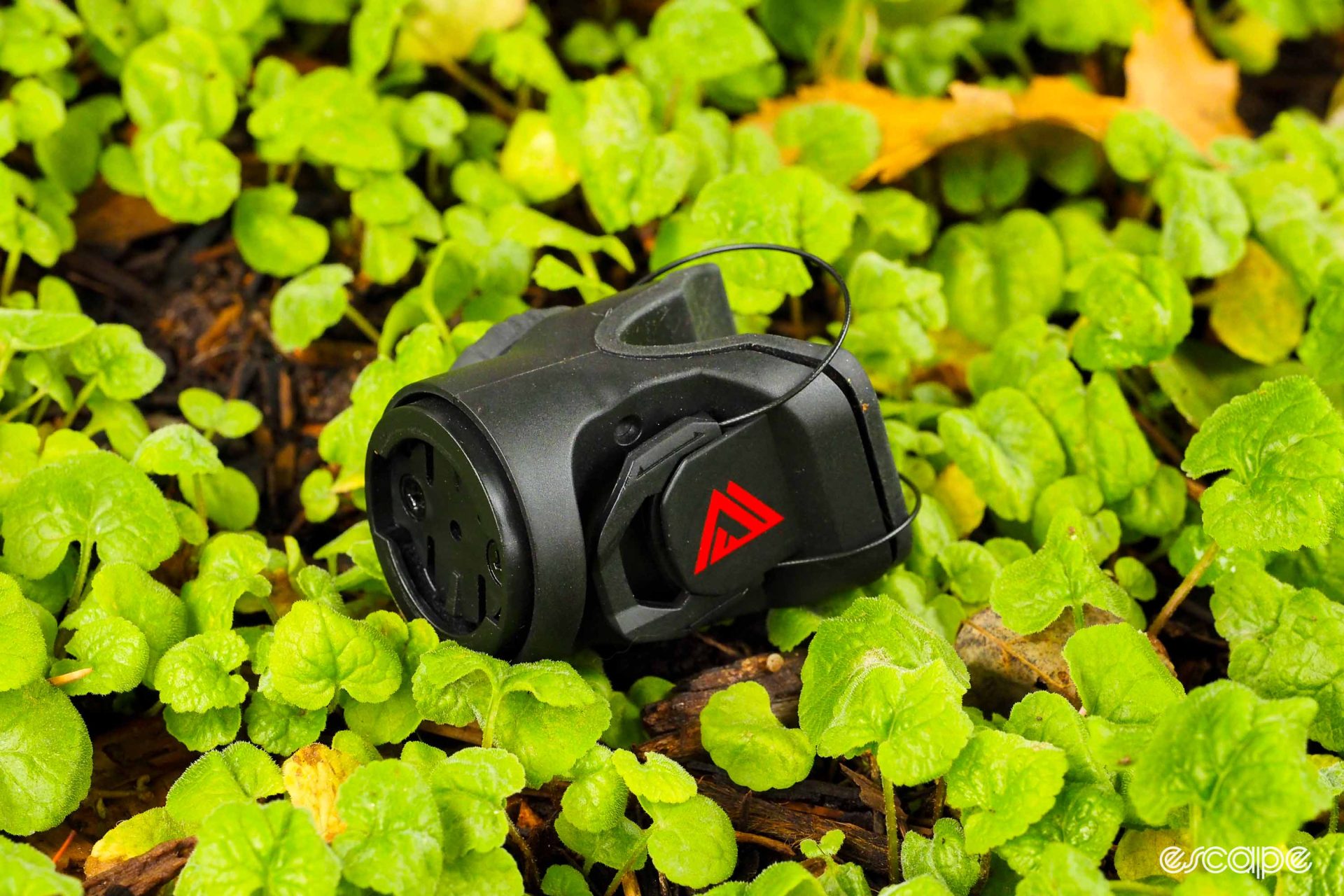
KOM Cycling Garmin Varia Mount – US$40 / AU$56 / £40 / €45; 42-45 g
I’d been aware of KOM Cycling’s Garmin Varia Mount for years, but had resisted getting one as it struck me as a little overly engineered for the task. After all, does a Varia mount really need a Boa-style cable reel to attach it to a seatpost? I mean, the stock mount may be crummy, but this is just over the top, right?
Sort of.
The KOM Cycling mount is reassuringly solid-feeling in your hands, like a little molded plastic brick. There’s only a single rubber shim included, but it’s designed to accommodate a range of different seatpost shapes, and when properly mounted, it’s a decidedly sturdy unit. The BOA-like Atop cable reel adds a higher-end feel to the whole thing, and there’s enough wire length to fit on bikes with particularly deep seatposts or seat tubes (a current-generation Trek Madone seatpost was no problem, for example). Once everything is in place – and assuming a good fit on your post – it yields a pretty secure hold.
Achieving a good fit can be quite tricky, though.
KOM Cycling was early to the aftermarket Varia mount game, perhaps to its detriment. The plastic base and rubber shim are shaped for round seatposts, but also sharp-edged aero-style seatposts that are no longer widely used. As a result, the mount is not only bigger than it probably needs to be, but it also doesn’t work great with more modern flat-backed profiles.
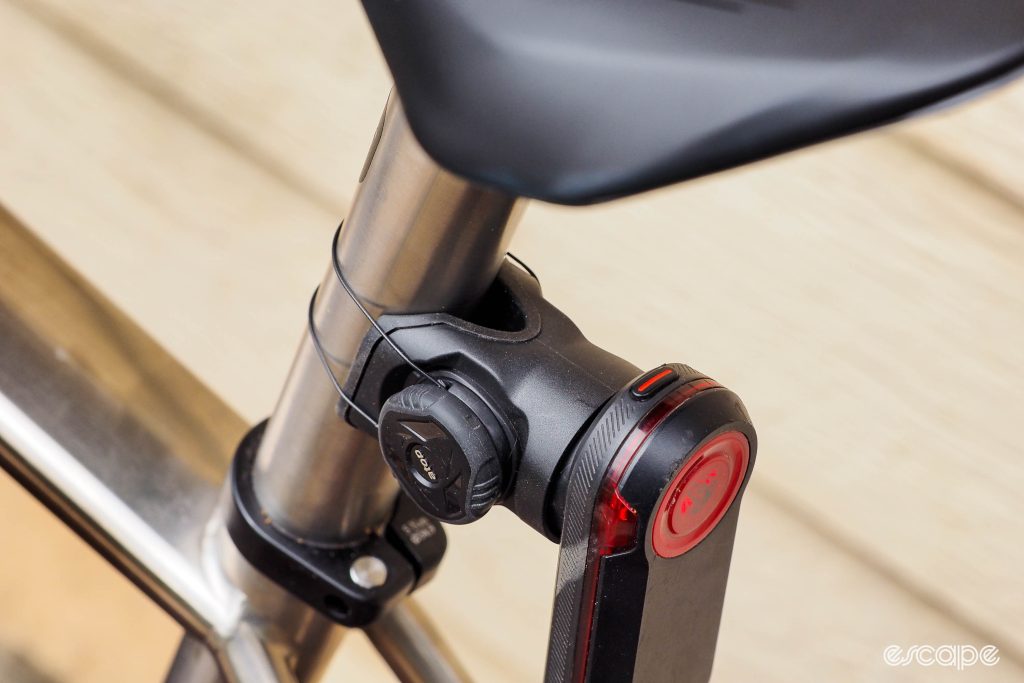
KOM Cycling sent with my mount its new “Hexa-Grasp” shim, which is designed to not only more closely follow the surface profile of a flat-backed seatpost, but also wrap around the sides of it a bit for a more secure hold. It’s a noticeable improvement over the stock shim on some – but not all – flat-backed surfaces, but still more prone to rotating around to the side than I’d prefer. Some of this is due to shape of the base (that central notch really is problematic), but it’s more because of a lack of stretch in one area, and a lack of squishiness in another.
If you’re not going to have a perfect fit for something like this, then there needs to be a certain amount of tension for things to stay put. The 3D-printed material KOM Cycling is using for the Hexa-Grasp shim is quite hard, while the Atop cable has almost no stretch to it. As a result, you need to crank the Atop dial very, very hard to get a secure hold, and the dial’s somewhat slippery surface makes that hard to do.
Overall, I’d say that if you’re regularly moving your Varia between multiple bikes and you’ve mostly got round seatposts, this would be a good option. Otherwise, the so-so fit on flat-backed shapes makes it hard to justify the higher price compared to some of the other mounts out there.
More information: www.komcycling.com.


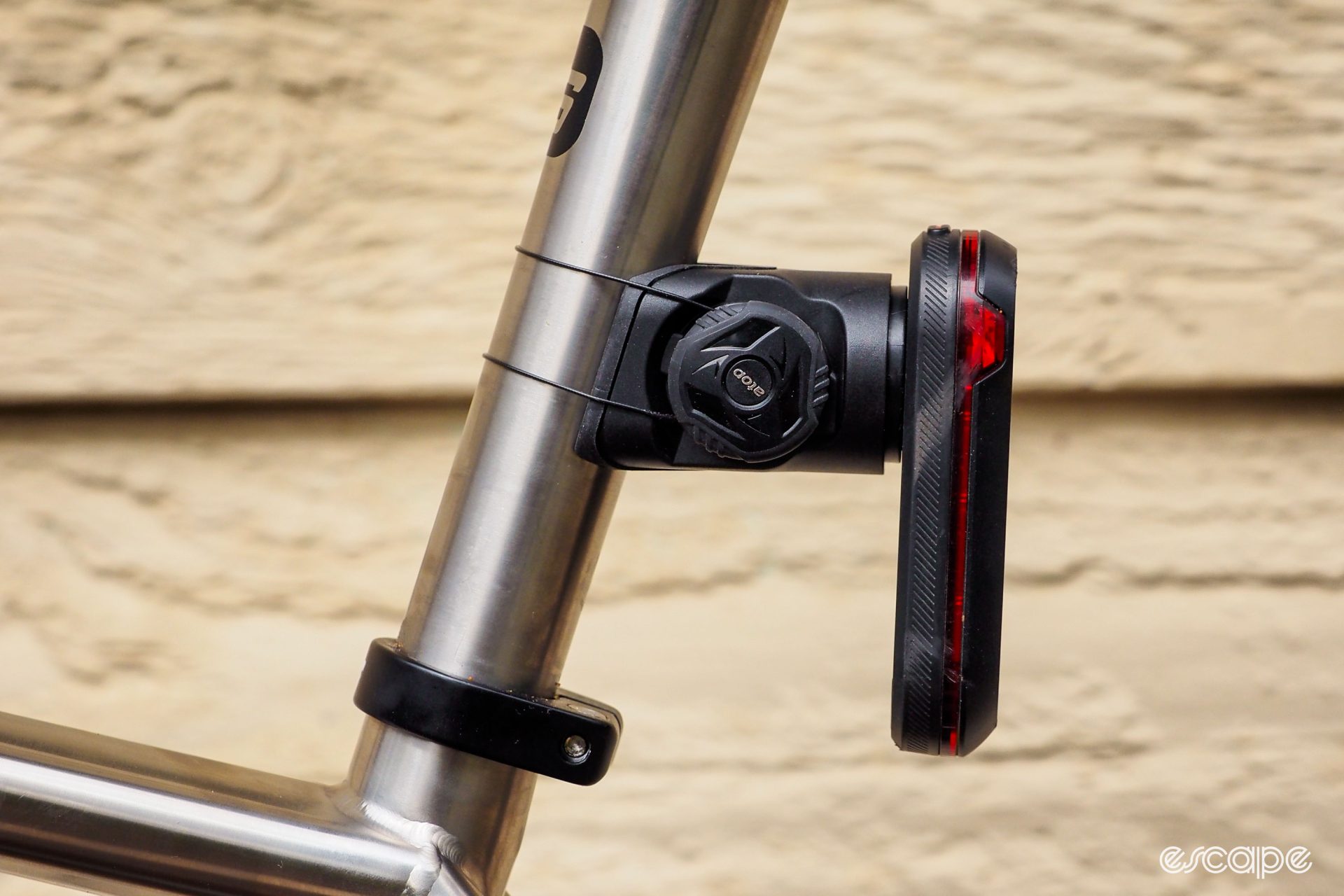

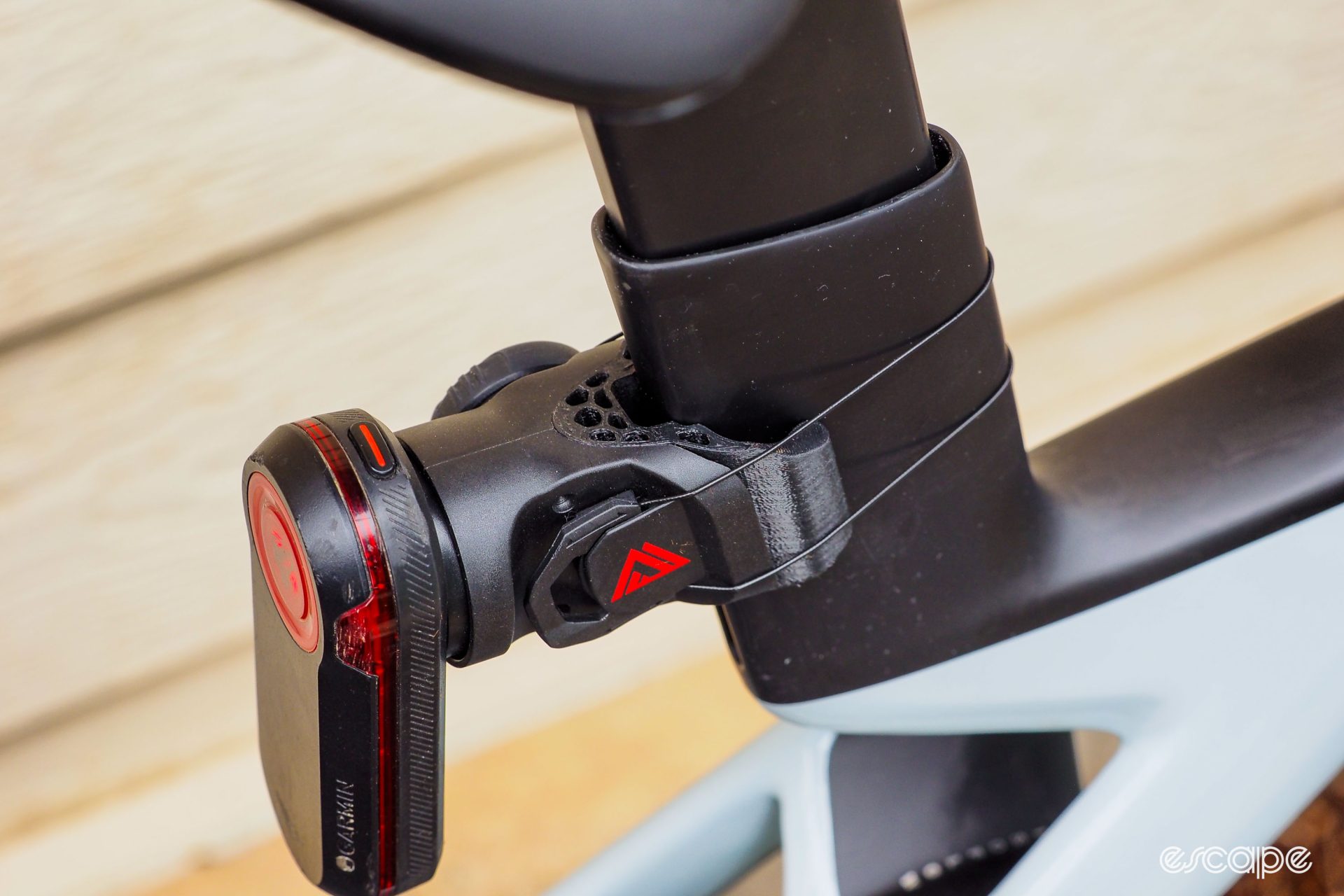
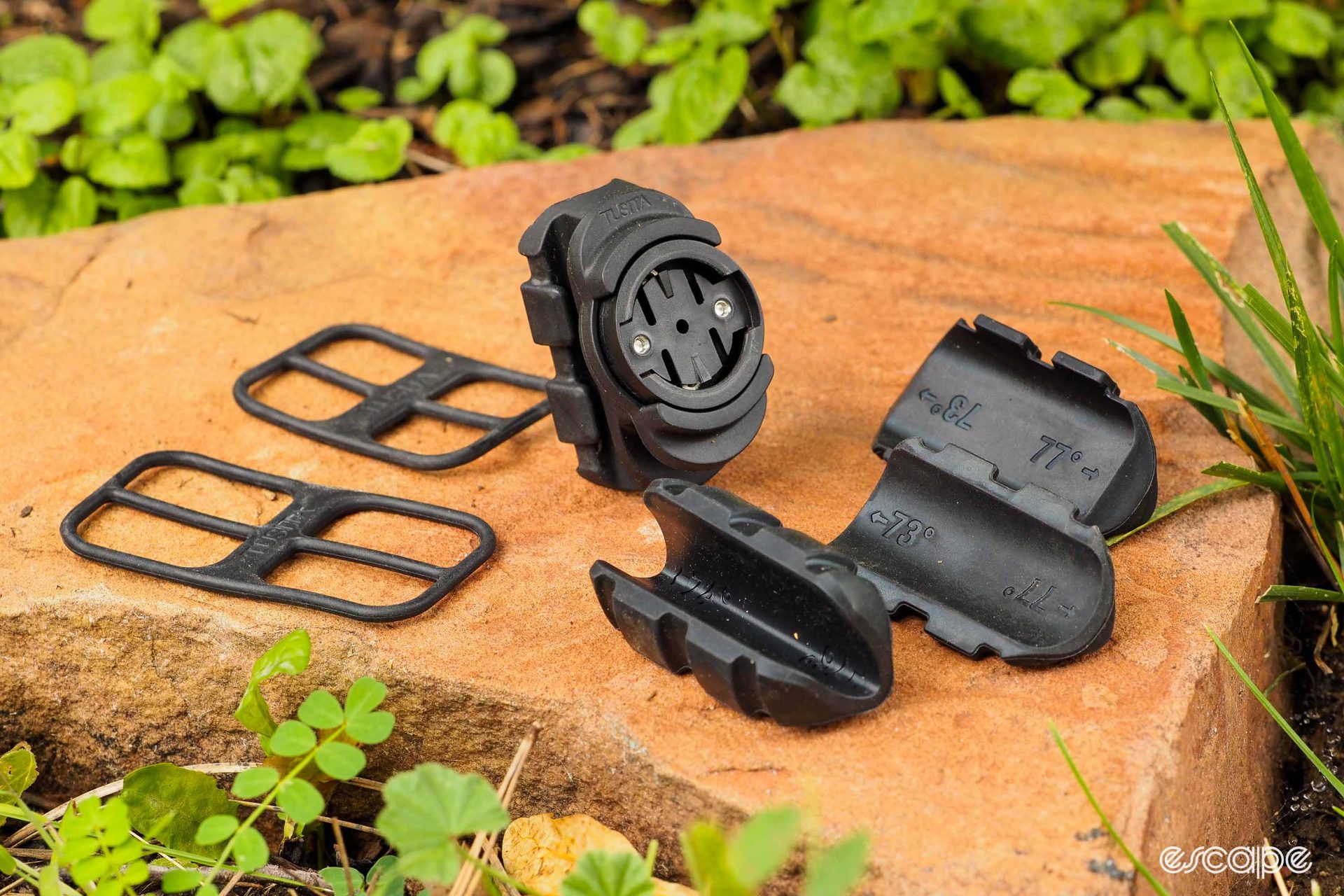
Tusita Bike Seatpost Mount – US$22 / AU$n/a / £20 / €22; 49-63 g
Tusita seems to be one of those brands that exist almost exclusively on Amazon. Its Amazon webshop offers a seemingly endless array of mobile accessories (and electronic golf widgets), but I can’t find a manufacturer site anywhere. Nevertheless, it was one of the more substantial-looking options I could find on the ubiquitous online superstore, so I figured I’d give it a shot.
The Tusita mount is a dead ringer for the mount Garmin includes with the bigger and heavier Varia RCT715, but with a standard quarter-turn mount that works with the other Varia models. Like the stock Varia mount, the Tusita one attaches with a single rubber strap, although unlike the wimpy Garmin unit, the Tusita straps feature double the number of attachment points. Two different rubber straps are included to handle different seatpost/seat tube diameters. There are also three different interchangeable rubber shims included – one for round seatposts, one for flat-backed ones, and one for sharp-edged ones – and each of those can be inverted to accommodate seat tube angles from roughly 73-77°.
No matter which shim you use, the straps are so tight that they’re hard to put on unless you’ve got some seriously strong fingers. The upside, however, is an incredibly secure hold. This thing is seriously rock solid – as in, no unwanted movement whatsoever. It doesn’t rotate around the post or slide down or vibrate or wiggle or anything. It’s the antithesis of the stock Varia mount.
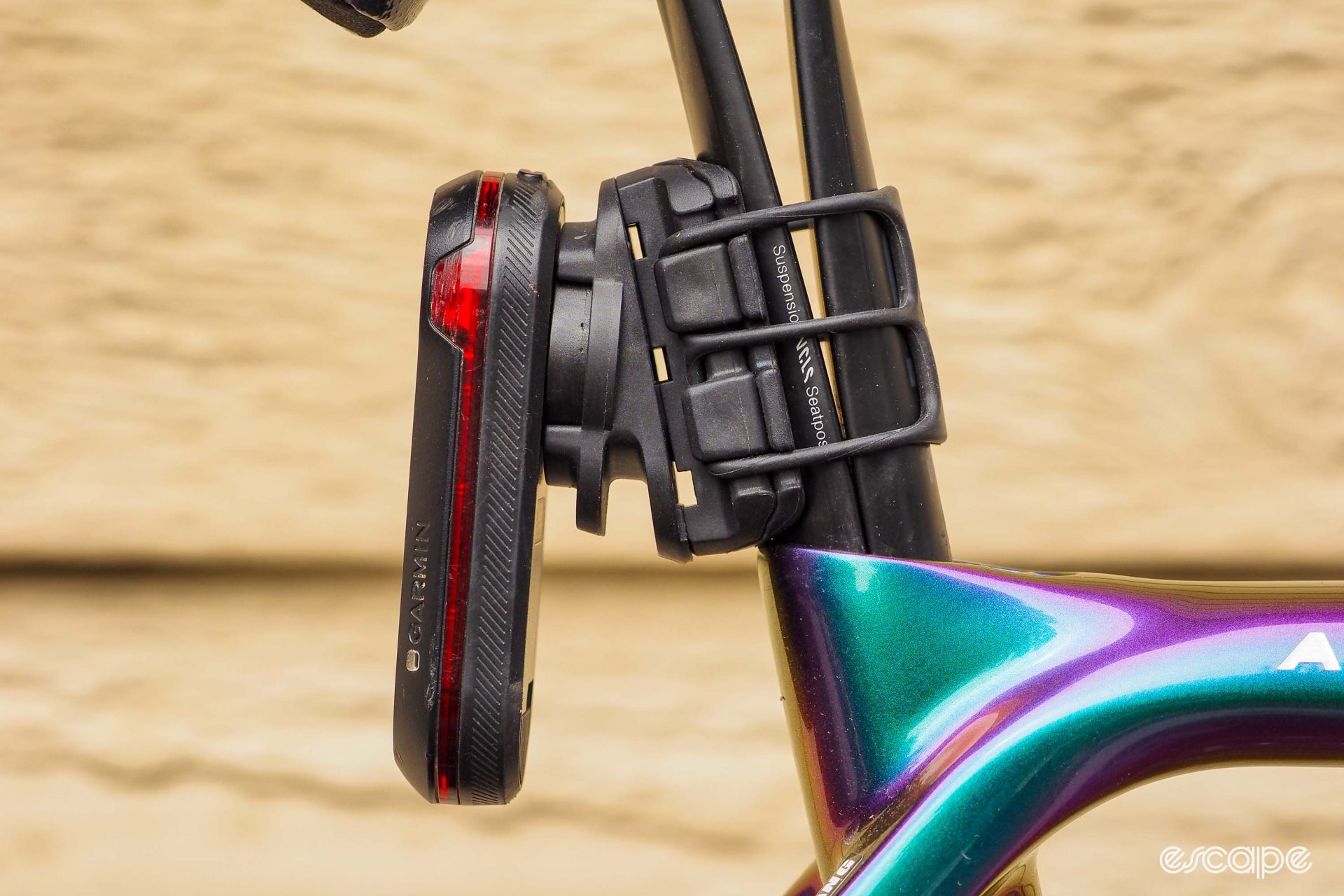
There’s extra peace of mind in the strap design, too. Whereas the stock Varia mount relies on that single o-ring, the Tusita strap’s pseudo-webbed design has built-in redundancy. Even if one elements tears, at least one more has to fail before your Varia goes bouncing across the tarmac.
And if that all isn’t enough, you can attach it with three (three!) zip-ties for a more semi-permanent installation.
While the security is great, the straps are so tight that you might not want to deal with it if you’re moving your Varia between multiple bikes. Neither of the straps are long enough to accommodate especially deep tube sections, either. In particular, triathletes on dedicated rigs might want to look elsewhere, although it’s also possible to use two longer rubber o-rings instead. But being an apparent knock-off, the Tusita mount is priced low enough that it wouldn’t be a huge hit on your finances to purchase more than one.
Unfortunately, none of the three included shims work well on slimmer flat-backed tubes. On a current-generation Trek Madone, for example, the sharp-edged shim was too narrow, but the flat-backed shim was too wide.
The other negative to the Tusita mount’s impressive solidity is weight. While the stock Varia mount comes in at a comparatively svelte 32 g, the Tusita one is 49-63 g (depending on strap and shim configuration) – even heavier than the more substantial-looking KOM Cycling mount.
More information: www.amazon.com.

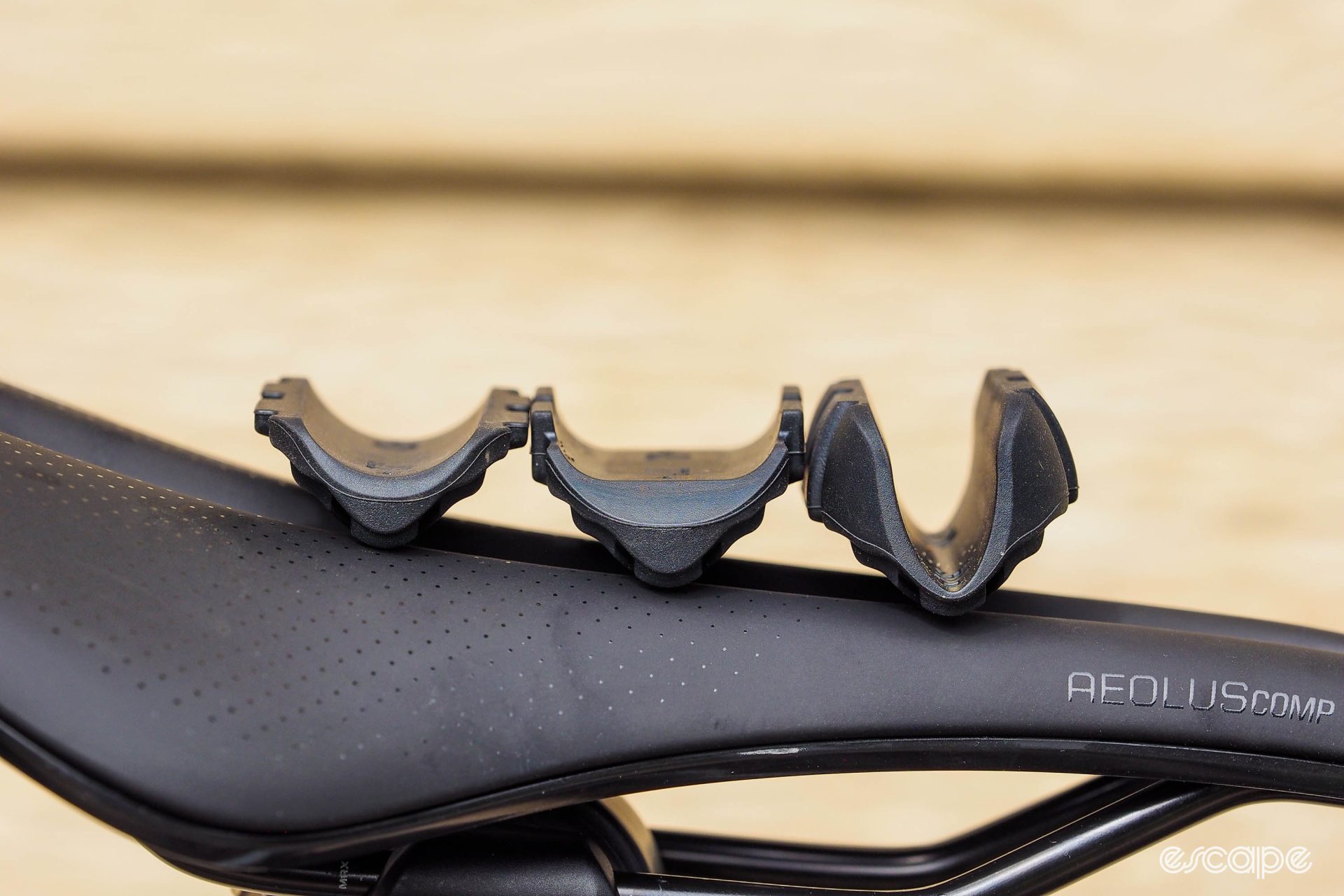
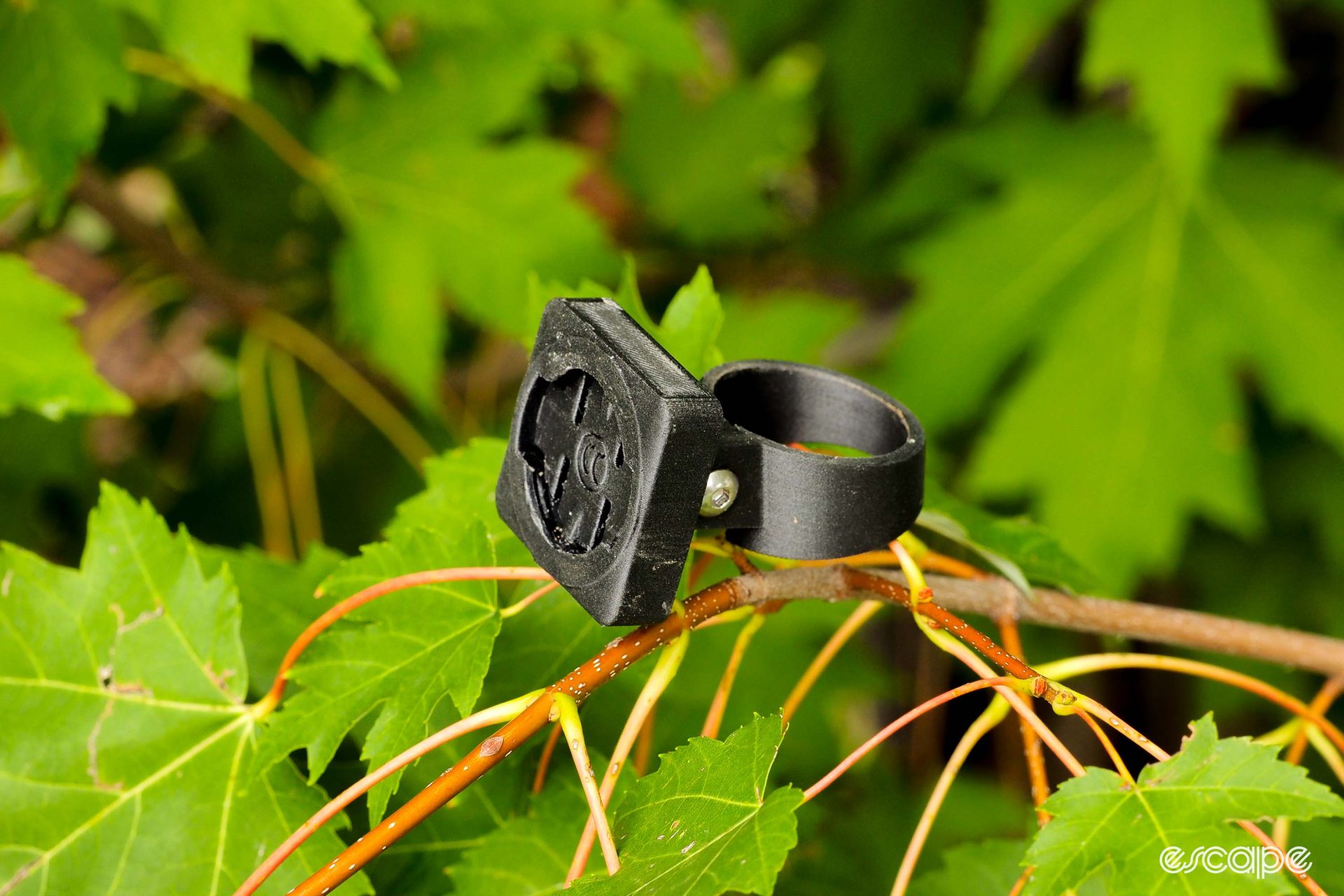
Concentric Cycling seatpost mount – US$26 / AU$39 / £TBC / €24; 21 g
One of the biggest advantages of modern 3D-printing technology is how quickly parts can be designed to accommodate just about any particular need – and all without having to resort to pricey dedicated injection molds like what both of the mounts mentioned above require.
Concentric Cycling is a small outfit in Perth, Australia whose entire business is almost wholly dedicated to Garmin Varia seatpost mounts. Instead of figuring out how to make one mount work for a wide variety of shapes and sizes, Concentric Cycling goes the other direction, making mounts that are designed to fit perfectly on one specific seatpost.
How specific are we talking here? Well, the brand currently offers five different mounts for round seatposts alone, as well as dedicated options for no fewer than 19 different bike brands. Concentric Cycling can even do fully custom options if you’re able to provide the part or frame in question (or, in my case, factory-supplied CAD drawings for my Enve Custom Allroad).
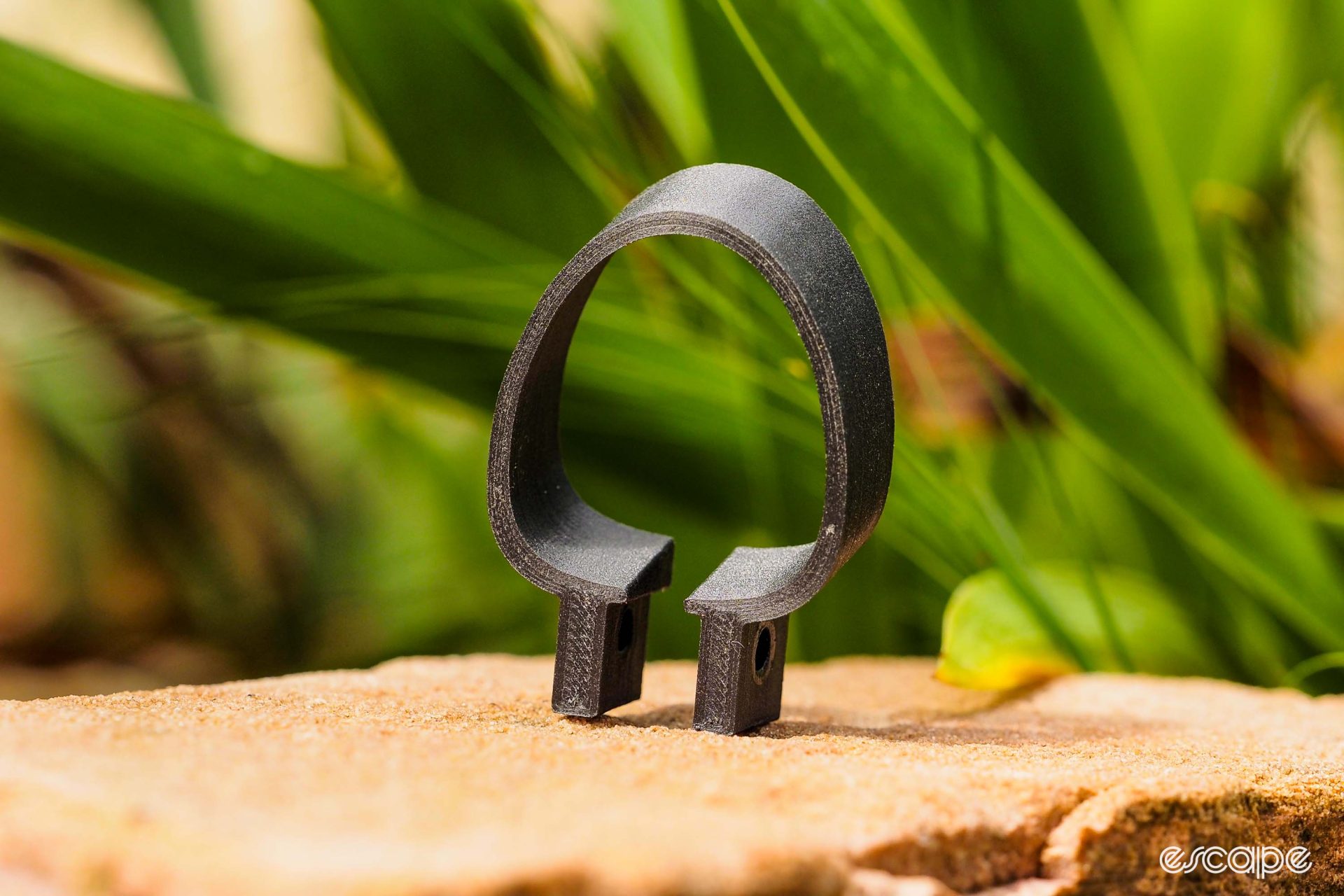
That means you’re unlikely to be able to move a Concentric Cycling Varia mount between multiple bikes unless they have identical post dimensions, but what you get in return are a low profile, a perfect fit, and very low weight – just 21 g for a standard 27.2 mm-diameter mount. The bolt-on attachment method holds tight yet looks unobtrusive, and between whatever high-quality filament is being used here and how closely the Varia is situated to the seatpost, there’s no excessive flex or vibration.
The printed construction does come with a rougher finish and they’re not exactly the most elegantly shaped things, and I’d also prefer the mounting interface to be more rounded to better match the profile of the Varia unit itself. But from a functional perspective, if you want a dedicated seatpost mount for one specific bike, these are a solid option.
More information: www.concentriccycling.com.

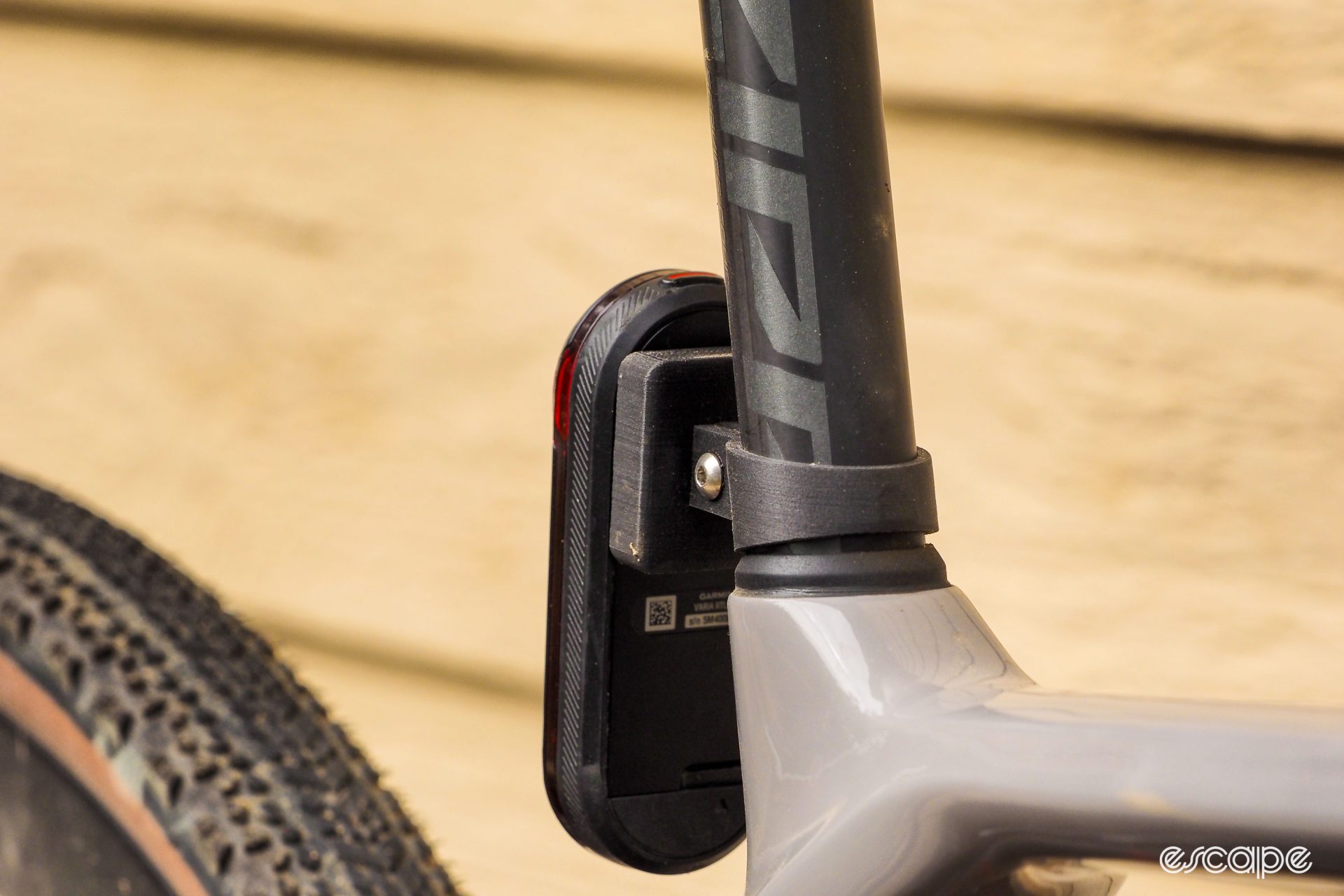


Garmin Varia Seatpost Quarter-Turn Mount – US$20 / AU$29 / £15 / €20; 23-26 g
As it turns out, Garmin also makes a sturdier clamp-on mount just for round seatposts – it’s just not included with the Varia since it doesn’t fit as many seatpost shapes and sizes. This one is a bolt-on unit with a hinged opening made of molded plastic, with keyed shims designed to fit seatposts from 27.0-31.6 mm in diameter.
If you have a round seatpost, I don’t have too many complaints about this one: it does the job and works as advertised, and – although this is a low bar – it’s a massive improvement over the stock o-ring mount.
Nevertheless, it sticks out sideways from the seatpost further than I’d like, which is not only a visual bummer but might result in some rubbing on your inner thigh. And since it bolts in place, it’s no quicker to move between bikes than the dedicated mounts from Concentric Cycling, which are identically priced but fit and look better.
More information: www.garmin.com.
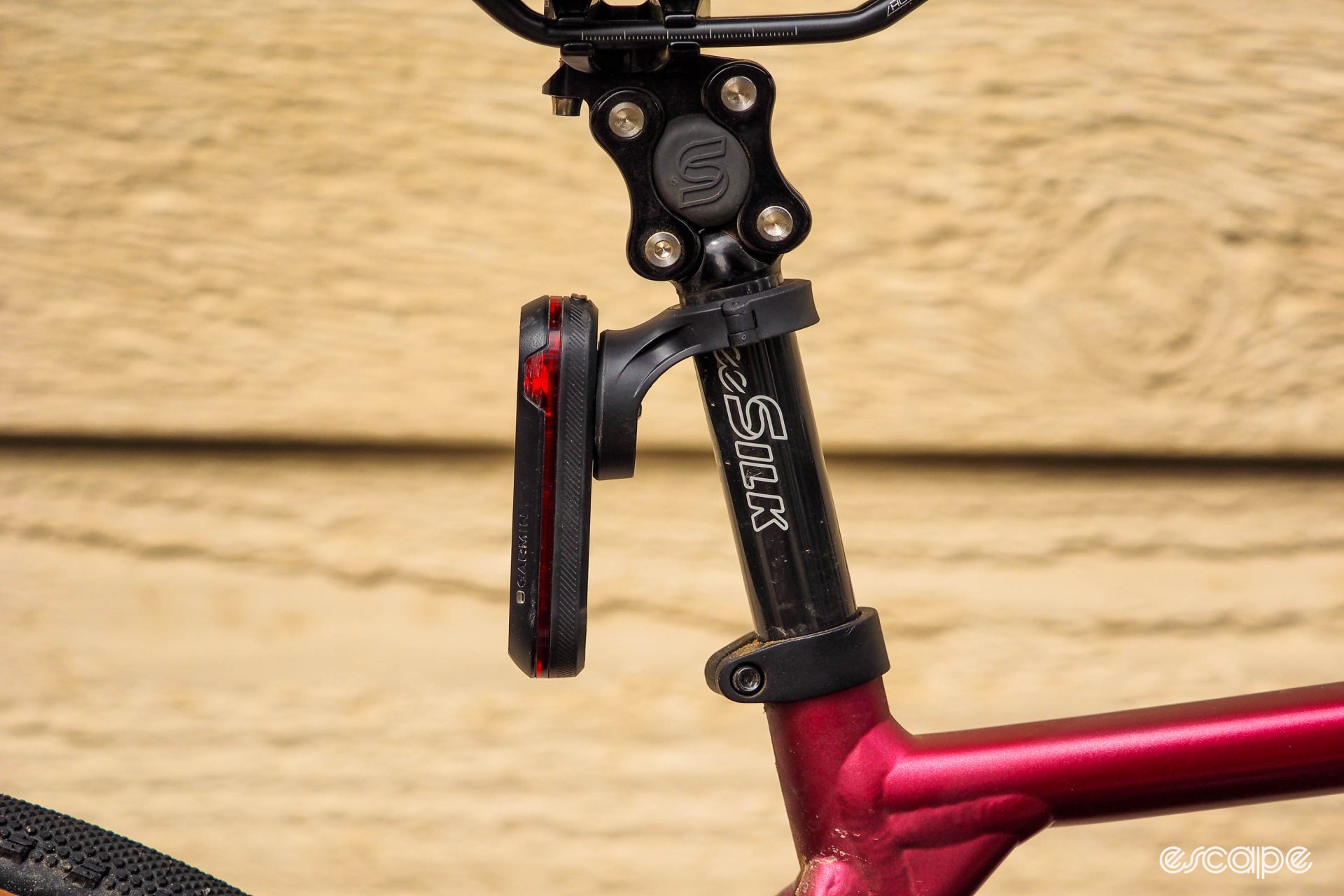
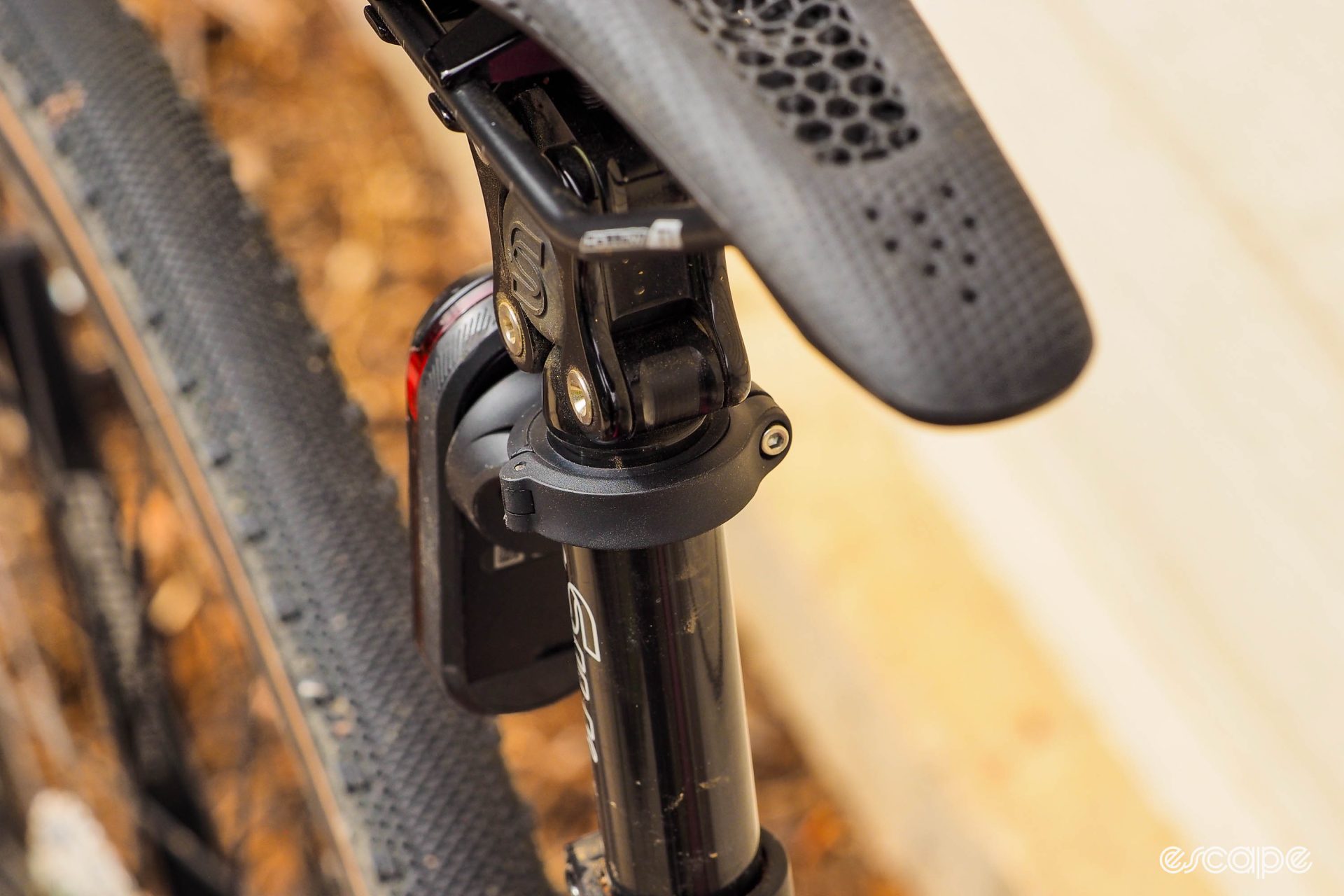
Even more options
I’ve only tried firsthand the options I’ve already mentioned above, but the rapid proliferation of cottage 3D-printing outfits means there’s no shortage of other options when it comes to elegantly (and securely) attaching your Garmin Varia radar unit.
For example, RaceWare Direct is a UK-based manufacturer with such an incredibly broad array that I wonder if anyone there sleeps at night. Want to attach your Varia directly to the accessory ports on the back of your Bontrager or Specialized saddle? How about to the saddle rails? Or perhaps you just want to utilize the clip attachment on the bag of your existing saddle pack? RaceWare Direct has all of those and more – oh, and make sure you specify if you want to add an AirTag holder, too. There are more models surely being added, too.
Another 3D-printing brand catering to the Garmin Varia crowd is MagCad. MagCad’s catalog isn’t as broad as RaceWare Direct’s, but there are quite a lot of options from which to choose, although most are saddle-based, not seatpost mounts.
There’s also US-based Bup Labs, who makes a modular saddle-based system with a variety of printed bases and accessory arms depending on your particular setup. Direct-mount for Specialized, Bontrager, or Syncros? Or do you just want to clamp to the rails? They’ve got you. Bup Labs’ ecosystem is based around the GoPro mounting interface, so while the company does have several fitments for various Garmin Varia models (including the bigger and heavier RCT715), that also means you can also use those bases to attach GoPro cameras (or most other things that use that mounting pattern). Just keep in mind that the two-piece design means you’re buying two parts instead of one, and the retail prices reflect that.
Speaking of GoPro, keep in mind there are countless widgets available (many from the brands mentioned just above) that adapt the Garmin Varia’s native quarter-turn mounting interface to the GoPro one. There’s an immense selection of accessories for this so-called “finned” standard, so if you’ve got a particularly challenging mounting problem (or just want to get creative), that could be another way to go.
A note on positioning
This doesn’t seem to be incredibly common knowledge, but Garmin actually has clearly defined guidelines for how its Varia radar units should be mounted on your bike.
Ideally, Garmin says the Varia should be mounted “as high on the seatpost as possible for optimal light visibility and radar detection.” Moreover, it should be situated “250 mm to 1,200 mm above the road,” and – of course – there should be nothing blocking the radar or light’s “view” of the road behind you.

Most saddle-based aftermarket mounts will satisfy these requirements automatically, but some care should be exercised when using seatpost mounts (regardless of which one). Although it seems fashionable to attach your Varia unit right at the base of the seatpost for a tidier look, that won’t always satisfy those guidelines so you might be compromising the performance of your safety device for the sake of vanity.
Personally, I like to go somewhere a little in-between – mostly because the idea of perching my rear end directly above a little electronic box spewing out radar waves makes me somewhat uneasy, but even so, I always make sure there’s nothing in its way for optimal performance.
You don’t have to settle
Count me among the Varia skeptics early on, but I’m a diehard user now – and if you don’t mind, I’d prefer it to stay attached to my bike instead of skittering across the road again.
As I mentioned early on, this article isn’t meant to be a “best of” or an exhaustively comprehensive overview. But that said, my point is that while the stock Garmin Varia mount is pretty woeful, you aren’t stuck with it – in fact, anything but. There are tons of alternative solutions on the market, and while some may be better than others, just about any one of them will be better than what Garmin includes.
What did you think of this story?

